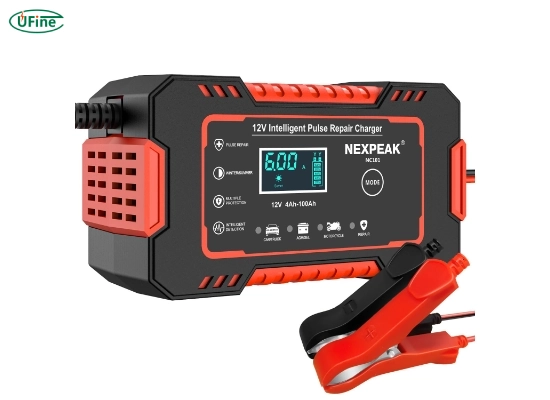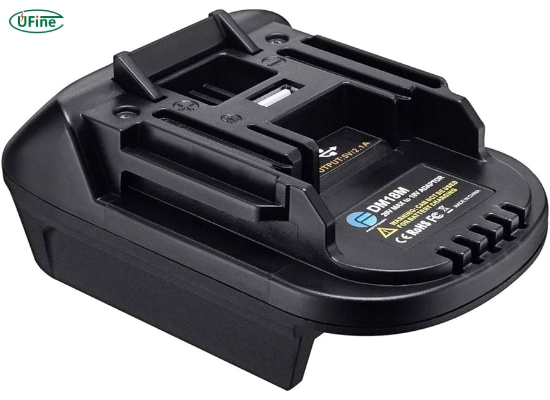Battery chargers and adapters are essential for anyone relying on rechargeable device batteries. Whether you’re powering a car, a cordless drill, or a smartphone, understanding how these devices work can help you choose the best options for your needs. In this comprehensive guide, we’ll explore the different types of battery chargers and adapters, their uses, and how to select the right one for your specific requirements.
Part 1. What is a battery charger?
A battery charger is a device that replenishes the energy stored in a rechargeable battery by forcing an electric current through it. Chargers vary widely in their design, functionality, and application. The primary goal of a battery charger is to restore a battery to its total capacity safely and efficiently.
Part 2. Types of battery chargers
Battery chargers come in several types, each suited for different applications and battery types. Here are the most common types:
Manual battery chargers
Manual battery chargers require the user to monitor the charging process and disconnect the charger once the battery reaches a full charge. These chargers continuously supply current to the battery, which can lead to overcharging if not carefully managed.
Automatic battery chargers
Automatic battery chargers stop charging once the battery reaches total capacity. They often switch to a maintenance or float mode, delivering small amounts of current to keep the battery at full charge without overcharging it. This feature makes them safer and more convenient for long-term use.
Trickle chargers
Trickle chargers provide a low, steady charge to maintain a battery’s charge over time. They are ideal for charging batteries during infrequent use, such as in seasonal vehicles or backup power systems.
Solar chargers
Solar chargers use solar panels to convert sunlight into electrical energy and charge batteries. They are eco-friendly and can be used in remote locations where traditional power sources are unavailable.
Part 3. How do you choose the correct battery charger?
Selecting the correct battery charger involves considering several factors, including the type of battery, the desired charging speed, and the specific application. Here are some steps to help you choose the correct charger:
Step 1: Identify your battery type
Different batteries require different charging methods. Common battery types include:
- Lead-acid batteries are used in cars, motorcycles, and backup power systems.
- Lithium-ion batteries: Common in smartphones, laptops, and cordless tools.
- Nickel-cadmium (NiCd) and Nickel-metal hydride (NiMH) batteries are used in older electronics and power tools.
Step 2: Determine the required charging speed
The charging speed depends on how quickly you need the battery ready. Faster chargers deliver more current, reducing charging time but potentially shortening battery life if not properly managed.
Step 3: Consider the application
Think about how and where you will use the charger. For example, a weather-resistant charger would be ideal for a vehicle that is stored outdoors. A multi-bank charger would be more efficient if you charge multiple batteries simultaneously.
Part 4. What is a battery adapter?
A battery adapter allows you to use batteries from one device in another device, often across different brands or voltage levels. This can be particularly useful for power tools, where a single battery type can power multiple tools, reducing the need for multiple chargers and batteries.
Part 5. Benefits of using battery adapters
Battery adapters offer several advantages, including:
- Cost savings: Using a single type of battery across multiple devices can reduce the batteries and chargers you need to purchase.
- Convenience: Swapping batteries between devices is easier and more efficient.
- Compatibility: Adapters can make older tools compatible with newer battery technologies, extending their useful life.
Part 6. Potential issues with battery adapters
While battery adapters can be beneficial, they also come with potential risks:
- Overheating: Using a battery with a higher voltage than the device is designed for can cause overheating and damage.
- Warranty voiding: Using third-party adapters may void the manufacturer’s warranty on your tools or batteries.
- Safety concerns: Adapters can bypass safety features built into the battery or device, increasing the risk of accidents.
Part 7. How to safely use battery adapters?
To safely use battery adapters, follow these guidelines:
- Check compatibility: Ensure the adapter is compatible with the battery and the device.
- Monitor usage: Monitor the device and battery for signs of overheating or other issues.
- Follow manufacturer guidelines: Adhere to instructions or warnings from the adapter, battery, or device manufacturer.
Part 8. Battery chargers vs. battery adapters: What’s the difference?
It’s easy to confuse battery chargers and adapters, but they serve different purposes. Here’s a comparison to clarify their distinct roles:
| Feature | Battery Charger | Battery Adapter |
|---|---|---|
| Primary Function | Recharges the battery by supplying electrical energy | Allows the use of one type of battery in a different device |
| Usage | Used when the battery needs to be recharged | Used to adapt a battery to fit and function in a different device |
| Types | Manual, automatic, trickle, solar | Brand-specific, voltage-specific |
| Safety Features | Often includes overcharge protection and automatic shut-off | May bypass some safety features, leading to potential risks |
| Application | Suitable for maintaining and recharging batteries in various devices | Useful for reducing the number of batteries and chargers needed for multiple devices |
| Risks | Overcharging if not monitored (manual chargers) | Overheating, warranty voiding, and potential safety hazards |
| Cost Implications | Generally a one-time purchase per battery type | Can save money by reducing the need for multiple batteries and chargers |
Part 9. FAQs
-
What is the difference between a manual and an automatic battery charger?
A manual battery charger requires the user to monitor the charging process and disconnect the charger once the battery reaches a full charge. An automatic battery charger stops charging automatically and switches to a maintenance mode to prevent overcharging. -
Can I use a solar charger for my car battery?
Yes, you can use solar chargers to charge car batteries. However, a charge controller prevents overcharging and ensures the battery charges safely. -
Are battery adapters safe to use?
Battery adapters can be safe if used correctly and with compatible devices. However, they can bypass safety features and cause overheating or damage if not used properly. -
How do I know if my battery is fully charged?
Many modern chargers feature indicators that show when the battery reaches a full charge. You can also use a voltmeter to check the battery’s voltage or a hydrometer for lead-acid batteries to measure the specific gravity of the electrolyte. -
What should I do if my battery gets hot while charging?
If your battery gets hot while charging, disconnect it immediately and allow it to cool down. Overheating can indicate a problem with the battery or charger, and continuing to charge it could be dangerous.
Related Tags:
More Articles

How to Choose the Best Floor Scrubber Battery for Commercial Cleaning?
Selecting the ideal floor scrubber battery ensures a long runtime, rapid charging, and minimal maintenance for efficient commercial cleaning operations.
Battery for Blower vs Battery for Leaf Vacuum: Which One Should You Choose?
Battery for blower vs leaf vacuum—learn the key differences in power, fit, and runtime to choose the right battery for your outdoor tool needs.
How to Choose the Right Battery for Blower?
Choosing the right blower battery? Consider voltage, capacity, chemistry & usage. This guide helps match the best battery for peak performance.
How to Choose the Best Insulated Battery Box for Lithium Batteries?
Choosing the Best Insulated Battery Box for Lithium Batteries? Discover key factors such as size, material, and safety for optimal protection and performance.
7 Critical Elements on a Lithium Battery Shipping Label
What must be on a lithium battery shipping label? Learn 7 key elements to ensure safety, legal compliance, and correct handling across all transport modes.





